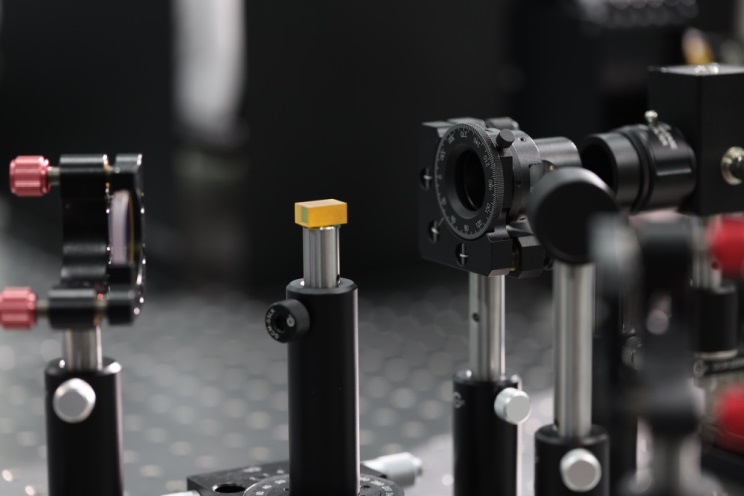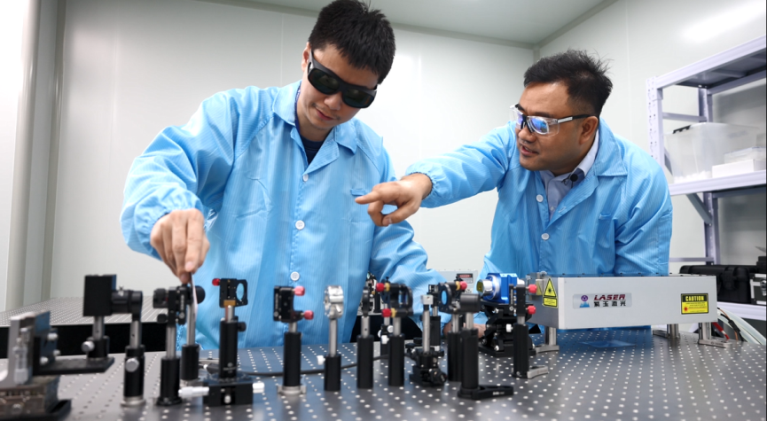Chinese Scientists Develop Highly-sensitive Mid-infrared Detection via BGSe Crystal

Mid-infrared detection system based on frequency conversion technique. (Image provided by SIACAS)
Shenyang Institute of Automation, Chinese Academy of Sciences (SIACAS) announced On January 25th that its Terahertz team has made important progress in infrared detection. Highly-sensitive detection of ns-pulses between 3 and 8 micrometers has been realized by using frequency conversion technique via BGSe crystal. It will help to promote cutting-edge research in the fields of biology, medicine, chemical engineering,etc. This work was published by Optica on January 20th.
Compared to traditional visible light and near-infrared (IR) rays, the interaction between waves and molecules can be stronger in case of mid-infrared. Moreover, the resonant phenomenon due to a certain wavelength within such a frequency band can help to improve the signal-to-noise (SNR) ratio in spectroscopy. Consequently, mid-infrared detection is important for explorations in life science, material science, and practical applications such as environment protection, medical diagnosis, etc. Current mid-infrared detectors are mainly based on thermo detection and opto-electronic detection mechanisms and sensitivity have been the bottleneck for accurate and quantitative characterization of infinitesimal traces of substances.
"Aiming at the limited sensitivity of mid-IR, we designed the system based on frequency conversion detection and realized it. The principle is to change weak mid-IR signals into near-IR signals effectively. Since the near-IR signals contain the information of mid-IR signals and they are very easy to detect, so that we can implement highly-sensitive mid-IR detection via such an indirect approach." explained QI Feng, researcher of SIACAS and also head of the team.
According to QI, the Terahertz team has analyzed nonlinear crystals systematically and decided to use the BGSe crystal,which was produced by YAO Jiyong from Technical Institute of Physics and Chemistry, Chinese Academy of Sciences.
"Generally, the BGSe crystal is applied as the source in the field of mid-IR, we proposed to use it at the detection side."said QI, "By thoroughly studying its optical properties, we optimized the phase-matching condition and realized effect detection of weak signals in case of a strong noise background. It is not easy but we made it and developed a decent mid-infrared system."

The BGSe crystal .(Image provided by SIACAS)
Experimental studies have been implemented and in case of ns-pulse detection, such a system is at least 100 times more sensitive than the HgCdTe detector. AJ-level pulses have been detected successfully. The dynamic range of the system is over 110 dB and the response is quite uniform over 3-8 μm, both parameters above outperform classical detection methods. Moreover, the performance can be improved further in future.

Scientists during experiments. (Image provided by SIACAS)
"Our research is driven by the actual demand, oriented by questions. Whenever we start a topic, we should consider practical applications first. Novel mechanisms and methods are prompted in our lab. We would like to do our best to make progress in case of challenging problems. It is our wish to make a breakthrough and contribute to scientific community.” said SHI Zelin, director of SIACAS, also Head of CAS Key Laboratory of Opto-Electronic Information Processing , "This highly sensitive detection of mid-IR is quite representative. If the sensitivity can be improved by orders, it will broaden the horizon of scientists and supply novel tools for biological and medical studies. Moreover, it can benefit chemical and environmental protection industries, by making tasks impossible originally feasible."
Contact:
QI Feng
Email: qifeng@sia.cn